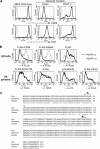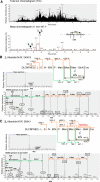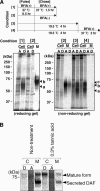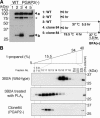PGAP2 is essential for correct processing and stable expression of GPI-anchored proteins
- PMID: 16407401
- PMCID: PMC1382328
- DOI: 10.1091/mbc.e05-11-1005
PGAP2 is essential for correct processing and stable expression of GPI-anchored proteins
Abstract
Biosynthesis of glycosylphosphatidylinositol-anchored proteins (GPI-APs) in the ER has been extensively studied, whereas the molecular events during the transport of GPI-APs from the ER to the cell surface are poorly understood. Here, we established new mutant cell lines whose surface expressions of GPI-APs were greatly decreased despite normal biosynthesis of GPI-APs in the ER. We identified a gene responsible for this defect, designated PGAP2 (for Post-GPI-Attachment to Proteins 2), which encoded a Golgi/ER-resident membrane protein. The low surface expression of GPI-APs was due to their secretion into the culture medium. GPI-APs were modified/cleaved by two reaction steps in the mutant cells. First, the GPI anchor was converted to lyso-GPI before exiting the trans-Golgi network. Second, lyso-GPI-APs were cleaved by a phospholipase D after transport to the plasma membrane. Therefore, PGAP2 deficiency caused transport to the cell surface of lyso-GPI-APs that were sensitive to a phospholipase D. These results demonstrate that PGAP2 is involved in the processing of GPI-APs required for their stable expression at the cell surface.
Figures







Similar articles
-
Human SND2 mediates ER targeting of GPI-anchored proteins with low hydrophobic GPI attachment signals.FEBS Lett. 2021 Jun;595(11):1542-1558. doi: 10.1002/1873-3468.14083. Epub 2021 Apr 24. FEBS Lett. 2021. PMID: 33838053
-
Inositol deacylation of glycosylphosphatidylinositol-anchored proteins is mediated by mammalian PGAP1 and yeast Bst1p.J Biol Chem. 2004 Apr 2;279(14):14256-63. doi: 10.1074/jbc.M313755200. Epub 2004 Jan 20. J Biol Chem. 2004. PMID: 14734546
-
Hypomorphic mutations in PGAP2, encoding a GPI-anchor-remodeling protein, cause autosomal-recessive intellectual disability.Am J Hum Genet. 2013 Apr 4;92(4):575-83. doi: 10.1016/j.ajhg.2013.03.008. Am J Hum Genet. 2013. PMID: 23561846 Free PMC article.
-
Trafficking of glycosylphosphatidylinositol anchored proteins from the endoplasmic reticulum to the cell surface.J Lipid Res. 2016 Mar;57(3):352-60. doi: 10.1194/jlr.R062760. Epub 2015 Oct 8. J Lipid Res. 2016. PMID: 26450970 Free PMC article. Review.
-
CHO glycosylation mutants: GPI anchor.Methods Enzymol. 2006;416:182-205. doi: 10.1016/S0076-6879(06)16012-7. Methods Enzymol. 2006. PMID: 17113867 Review.
Cited by
-
Glycosylphosphatidylinositol anchors regulate glycosphingolipid levels.J Lipid Res. 2012 Aug;53(8):1522-34. doi: 10.1194/jlr.M025692. Epub 2012 May 24. J Lipid Res. 2012. PMID: 22628614 Free PMC article.
-
The Sphingolipid Biosynthetic Pathway Is a Potential Target for Chemotherapy against Chagas Disease.Enzyme Res. 2011;2011:648159. doi: 10.4061/2011/648159. Epub 2011 Apr 19. Enzyme Res. 2011. PMID: 21603271 Free PMC article.
-
Biosynthesis and biology of mammalian GPI-anchored proteins.Open Biol. 2020 Mar;10(3):190290. doi: 10.1098/rsob.190290. Epub 2020 Mar 11. Open Biol. 2020. PMID: 32156170 Free PMC article. Review.
-
TEX101, a glycoprotein essential for sperm fertility, is required for stable expression of Ly6k on testicular germ cells.Sci Rep. 2016 Mar 23;6:23616. doi: 10.1038/srep23616. Sci Rep. 2016. PMID: 27005865 Free PMC article.
-
Mutations in PGAP3 impair GPI-anchor maturation, causing a subtype of hyperphosphatasia with mental retardation.Am J Hum Genet. 2014 Feb 6;94(2):278-87. doi: 10.1016/j.ajhg.2013.12.012. Epub 2014 Jan 16. Am J Hum Genet. 2014. PMID: 24439110 Free PMC article.
References
-
- Ahmed, S. N., Brown, D. A., and London, E. (1997). On the origin of sphingolipid/cholesterol-rich detergent-insoluble cell membranes: physiological concentrations of cholesterol and sphingolipid induce formation of a detergent-insoluble, liquid-ordered lipid phase in model membranes. Biochemistry 36, 10944–10953. - PubMed
-
- Brewis, I. A., Ferguson, M. A., Mehlert, A., Turner, A. J., and Hooper, N. M. (1995). Structures of the glycosyl-phosphatidylinositol anchors of porcine and human renal membrane dipeptidase. Comprehensive structural studies on the porcine anchor and interspecies comparison of the glycan core structures. J. Biol. Chem. 270, 22946–22956. - PubMed
-
- Brown, D. A., and Rose, J. K. (1992). Sorting of GPI-anchored proteins to glycolipid-enriched membrane subdomains during transport to the apical cell surface. Cell 68, 533–544. - PubMed
Publication types
MeSH terms
Substances
LinkOut - more resources
Full Text Sources
Other Literature Sources
Molecular Biology Databases
Miscellaneous

